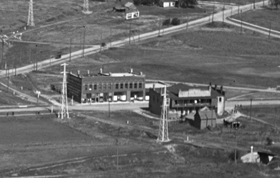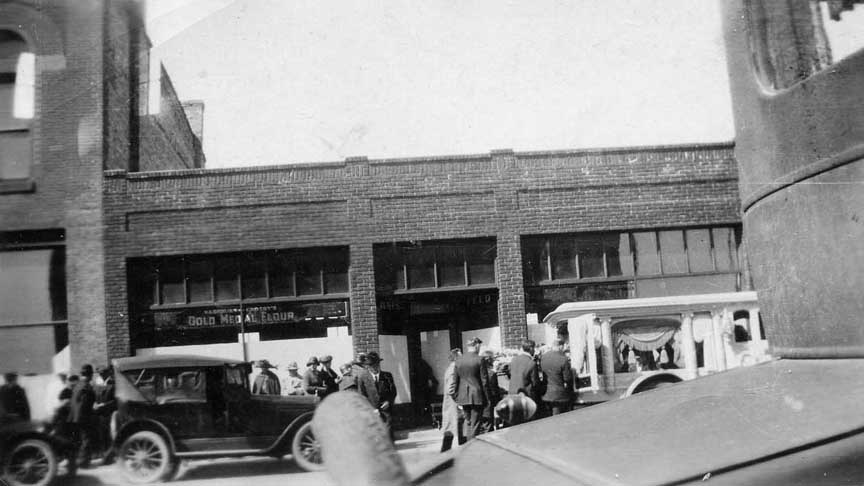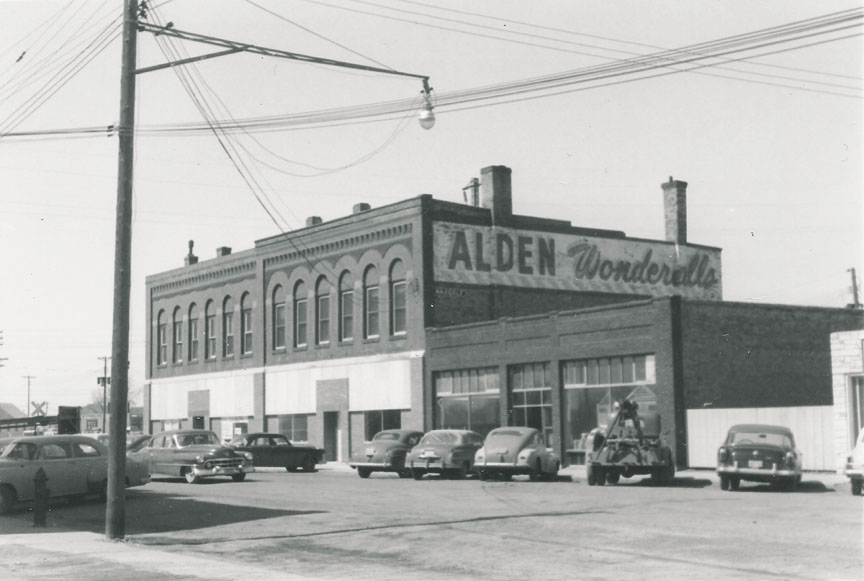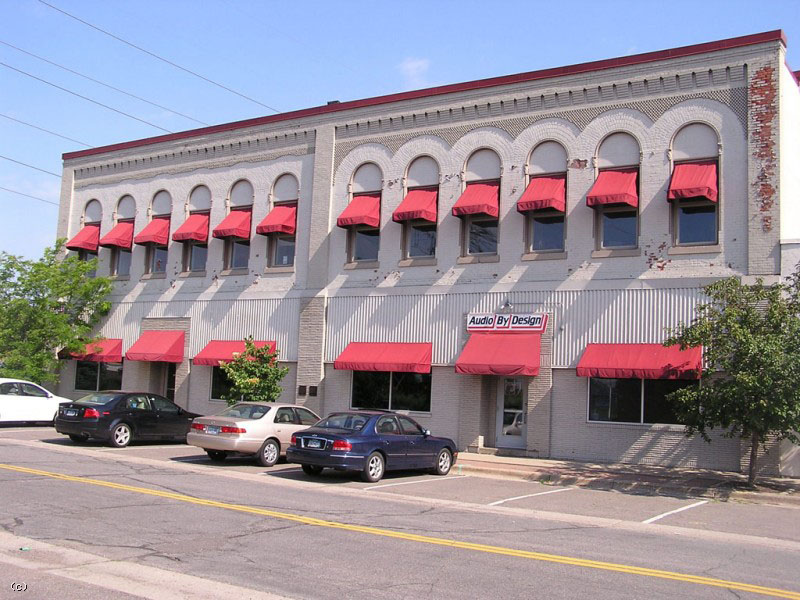T.B. Walker started building his two-story brick Walker Building in 1888 and completed it in 1892. The Walker Building was also known as the Syndicate Building. Together the Walker Building and the Hamilton Building across the street were known as the Brick Block. The 6400-6500 blocks of Walker Street made up St. Louis Park’s original commercial district, as laid out in the Rearrangement of St. Louis Park plat that was filed in 1892 by T.B. Walker’s Syndicate, the Minneapolis Land and Investment Company. The original name of the street was Broadway. The story of how T.B. Walker laid out the Village is spelled out in detail on the Walker page.
Note that T.B. Walker built many buildings in Minneapolis, and several of them at one time or another have been known as “The Walker Building.” One was at 8th and Hennepin, and another at 27th and Lake Street.
Although there are no photos that we know of to show this, it is believed that the Walker Building was originally in three two-story sections. On the first floor were storefronts that housed small businesses, some of which are listed below. The second floor was thought to be a meeting hall, much like the Hamilton Building’s second floor housed the Odd Fellow’s Hall.
FIRE AT THE WALKER
Early on February 3, 1917, a huge fire hit the Walker Building; the Minneapolis Tribune made it sound like the entire Village was at risk of burning down. The fire started at the meat market of A.M. Shields. The blaze was discovered by Dan Saara, who ran a rooming house on the second floor of the Walker Building that housed 100 men who worked at the Monitor Drill. The report says “Because of a high east wind, hope of saving the building was abandoned early, and all efforts were turned toward preventing a spread of the flames. An engine company was called from Minneapolis, but they got stuck in the snow three miles away. The firemen walked the rest of the way and gave what assistance they could.”
It is believed that after the fire, the eastern section was only built back to one story. That building is 6512 Walker Street, a separate but connected building today.
One curious note from the Commercial Club minutes of July 1917 indicates that Mr. Gorham (presumably the manager of the building) refused to put in heat or toilets in the upstairs of the Walker building.
The earliest extant photo that we have is an aerial from 1922, showing the Walker Building (north) facing the Hamilton Building. The diagonal street is Lake Street, which is lined with power poles for the streetcar.

An intriguing clue as to how it originally looked like comes from the photo below of Ole Larson’s funeral, taken in 1924. Although this is the one-story section of the building, at left you can see just how large the windows were in the two-story section

BUSINESSES OF THE WALKER BUILDING
Like the Hamilton building, businesses came and went, and moved from one building to the other. The Village did not have a directory until 1933 or a regular newspaper until 1941, so names of stores have been collected as best we can. Storefronts housed such concerns as:
- Doc Brown’s barber shop and pool hall, 1904 to 1907 and again from 1910 to 1942
- Stile Drug Store, which occupied the west part of the building
- Anderson Bros. Dry Goods
- Lambert Butcher Shop
- Acme Venetian Blinds
- Athens Restaurant, 1917
- A.M. Shields Meat Market, 1917
- N. Dworsky & Son General Merchandise and Grocery,1917
- The American Legion met on the second floor of the Walker Building until its own building was built on Excelsior Blvd.
- The Wilson Rubber Packing Co. (“a war project”) was a tenant in 1942 before it became Minnesota Rubber.
- There was even a small moving picture house operated by Jake Werner and Eric Liljenfors in 1915-1917. The men never resumed business after the fire.
- The fire department was located at the Walker Building until the 1917 fire when it moved to Monitor Drill.
- Park Woolen Mill, October 1953 (6524)
- In one memoir there was a chicken hatchery on Walker Street
- Park Press was advertised in the Echo in September 1950: Headquarters for School Supplies (6516). It was also in the 1951 and 1962 directories. In 1954-55 Park Press was listed in the Echowan at 3406 Louisiana (now Library Lane), and then in 1962 back at the Walker Building.
- The Dutch Mill Dairy Bar advertised in the 1950 and 1951 Echo (6518). It featured ice cream, lunches, dairy products, cold drinks, and candy. The business was apparently at 6510 in 1947 – 1950.
- Shurson Real Estate, 1933 to March 1941. Shurson was left with the task of selling of all of T.B. Walker’s unsold lots after his grand plan fell through. In 1941 he moved to a small building that is now the parking lot of 3550 Dakota Ave.
- The Spoolie Curler Co., 1959 (6520)
- Pierre Lenmark Co., 1961
- Wonderalls children’s clothing company, 1945 – 1953 (6524-A)
- Gleason Graphics, 1975 (6518)
- Audio by Design, 1999
The building was sold at auction on September 24, 1942 for $10,100. E.C. Ruble of Willmar bought the large two-story section of the building for $7,000. The one story section was purchased for $3,100 by J.K. Seirup. Another one story separate building was purchased by developer Douglas Rees for $600.
Some time between 1942 and 1954, Lewis Feldman became the owner of the building.
THE MANUFACTURERS’ AGENTS BUILDING
In May 1954, Feldman sold the building to Bruce McLouth. An article in the Minneapolis Star on May 16 reported that McLouth was remodeling the property, and that he had already added a new front. Presumably this would entail the metal over the windows and/or a new brick facade.
McLouth’s intent was to lease the building to agents representing various factories. He renamed it the Manufacturers’ Agents Building, and planned to provide office and warehouse space, a switchboard, and stenographic service to his tenants.
The article gives some history of the building, but might be taken with a grain of salt, since it says that T.B. Walker “decided to found a new city in competition with Minneapolis.” Walker, in fact, loved Minneapolis, and his interest in St. Louis Park was to bolster the manufacturing capacity of the City, and someday have Minneapolis annex the Park.
More history from the article:
- The building originally was composed of four stores with apartments above.
- Later the second floor was remodeled into offices and a lodge hall.
- Recently the second floor was used for light manufacturing space.
When the metal was installed the windows were shortened considerable. They are now 9 feet across and 4 feet high.

In 1954, when Manufacturers’ Agents were courted as tenants, the first to lease space included:
- Two branches of American Radiator Corp
- General Controls
- Tuttle & Bailey Manufacturing Co.
- Sales Engineers (McLouth’s company)
- Field Control Division of H.C. Conkey Co.
- Brundage Co. of Kalamazoo, Michigan
- National Steel Construction Co.
- K.T. Brokerage Co.
- S.H. Bartlett, 1965
- National Industrial Insurance Agency, 1976
A one-story addition was built in the back of the building in the 1960s. This concrete block addition is used as a garage and warehouse.
AUDIO BY DESIGN
In 1999 the building was upgraded by its new owner, 19th Century LLC, with new windows, awnings, stucco on three sides, electrical, plumbing, and other improvements. The building has been well cared for and is up to 21st Century standards, while retaining its 19th Century look.
The Walker Building still stands today as a functioning office building on Walker Street. It is St. Louis Park’s oldest commercial building and a lasting legacy of the influence of T.B. Walker on the earliest days of the Park.

